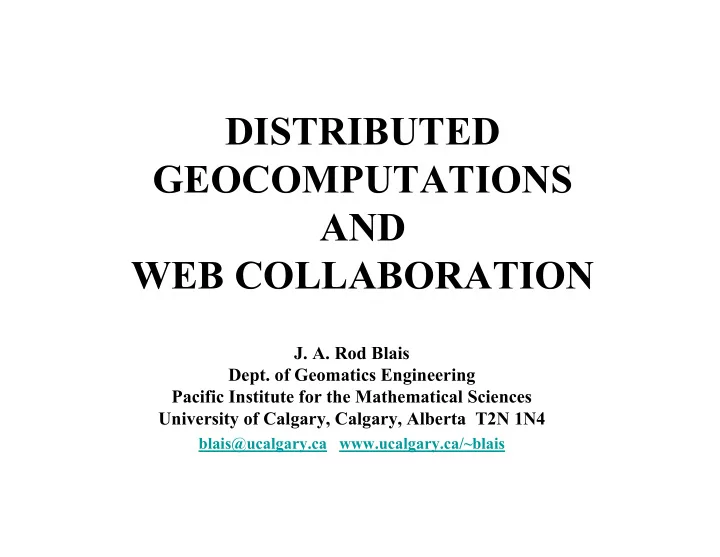

DISTRIBUTED GEOCOMPUTATIONS AND WEB COLLABORATION J. A. Rod Blais Dept. of Geomatics Engineering Pacific Institute for the Mathematical Sciences University of Calgary, Calgary, Alberta T2N 1N4 blais@ucalgary.ca www.ucalgary.ca/~blais
OVERVIEW • Geoscience and Related IT Challenges • New Cyberinfrastructure and Implications • Advanced and Distributed Geocomputations • Virtual Globes, Observatories and HUBs • Sensor Networks and Sensorwebs • Geosciences Network and Open Earth Framework • Examples: Turtle Mountain, glaciers, … • Web collaboration and potentials • Semantic Web and Implications • Concluding Remarks
GEOSCIENCE & IT CHALLENGES • Exponential increase in data volumes • Complexity and diversity of observations/measurements • Data processing, integration, fusion and preservation • Computational challenges and reproducibility • Advanced visualization in 3D and 4D • Archiving publications with reusable components • Web access as new pathway to scientific discovery ► Distributed geocomputations and web collaboration are the way of the future in the Earth (and other) sciences!
CYBERINFRASTRUCTURE • Classical infrastructure: roads, mail service, utilities, etc. • New infrastructure: advanced communications, high performance computers, advanced research networks, 3D & 4D visualization tools, data storage facilities, networks of remote sensors, advanced collaboration facilities, etc.
CI FRAMEWORK Source: Cyberinfrastructure Whitepaper, Alberta’s Research Infrastructure, 2006
DISTRIBUTED COMPUTATIONS • Defined in many different ways in different contexts • Distributed computing means using resources over a network • Computations include simple to complex varied tasks • Closely related to parallel computing for concurrent tasks • Subset of Grid Computing for HPC over extensive networks • Examples : – DataGrid (www.eu-datagrid.org) led by CERN and five other partners – Distributed Net (www.distributed.net) in cryptographic applications – Particle Physics Data Grid (www.ppdg.net) by ANL, BNL, Caltech, … – SETI@Home (setiathome.ssl.berkeley.edu) for extraterrestrial life – BOINC (boinc@berkeley.edu) for volunteering computing cycles – LAS (www.ferret.noaa.gov/LAS) Live Access Server at NOAA/PMEL
VIRTUAL GLOBES/OBSERVATORIES/HUBS Virtual Earth Globes for displaying and visualizing information: GOOGLE TM EARTH ( http://earth.google.com ) • Microsoft Virtual Earth ( http://www.microsoft.com/virtualearth/ ) • Poly9 FreeEarth ( http://freeearth.poly9.com ) • Virtual Observatories for sensors, data, tools and computations: National Virtual Astronomical Observatory ( http://us-vo.org ) • Virtual Geomagnetic Observatory ( http://mist.engin.umich.edu ) • Virtual HUBs for Linux Apache servers with LDAP, PHP, Joomla: HUBzero and nanoHUB ( http://www.hubzero.org ) • Demo with nanoHUB (http://www.hubzero.org/demo.html ) •
GEOSCIENCES NETWORK (www.geongrid.org)
Source: www.geongrid.org
EUROPEAN NETWORKS Distributed European Infrastructure for Supercomputing Applications DEISA (www.deisa.eu) (Consortium of HPC infrastructures and services) EGEE (www.eu-egee.org) Enabling Grids for E-Science (Largest multidisciplinary grid infrastructure in the world, with > 80,000 CPUs, > 300 sites, >2x10 16 B of data storage) DEGREE projects (www.eu-degree.eu): (a) GeoCluster (www.cggveritas.com/default.aspx?cid=4-13-1925) Seismic data processing, imaging and underground reservoirs (b) Institut du Globe de Paris on EGEE (geoscope.ipgp.jussieu.fr) Seismic early warning system for natural hazards (c) Global Ozone Monitoring Experiment on ERS Neural network using atmospheric ozone profiles & LIDAR data (d) Coupled Variable Density and Saturation in 3-D (www.eumedgrid.org) Finite Element and Monte Carlo simulation experiment
SENSOR NETWORKS & WEBS An amorphous network of spatially distributed sensor platforms (pods) • that (wirelessly) communicate with each other [Delin, 1997] A Sensor Web also refers to sensors connected to the Internet or WWW • OGC’s Sensor Web Enablement (SWE) aims at interoperability • standards including SensorML, an extension of XML [Reichardt, 2003] SWE supports heterogeneous sensors, models, simulations and decision • support tools in compliance with SOA principles SWE has standard specifications for Encodings and Web Services • Realizing visions of a worldwide Sensor Web will take some time … • Interoperability of information has enormous potential for • the scientific community, including geoscience, infrastructure and environment management, intelligence, security and even the general public
TURTLE MOUNTAIN (www.ags.gov.ab.ca/geohazards/turtle_mountain) 1903: Catastrophic rock avalanche that buried the town of Frank, AB • 5x10 6 m 3 of rock in South Peak area are likely to fail again (J. Allan) • 2003-2005: Large multidiciplinary study led to Geological Report • 2005: Program & Budget for long-term monitoring and studies • First priority: early warning for possible rock avalanche • Second priority: field laboratory for research community • Sensor network: some 40 state-of-the-art sensors such as • – 22 crackmeters, 5 extensometers, 10 tiltmeters – 11 dGPS receivers, 19 reflective prisms – 6 station passive seismic network, weather station Website: Geology, GIS Maps, Reports, Services, Search • Online digital images and other data available for analysis •
Source: www.depiction.com
Salmon Glacier, Northern BC
Source: IPCC Working Group II Fourth Assessment Report, 2007: Figure 1.1
WEB COLLABORATION KEY FEATURES: • Interactive Simulation Tools and Online Presentations • Mechanism for uploading New Resources • Tool Development Area and Usage Statistics • User Groups for Private Collaboration • Ratings and Citations and User Support Area • News and Events, and Feedback Mechanisms
SEMANTIC WEB Proposed by the inventor of the WWW: Tim Berners-Lee • Objective: users and machines to analyze all the data on the web • WWW ≡ ‘Information Space’ with URLs → URIs • Definitions and Descriptions: • Machine-readable view [Degaldo, 2001] Intelligent agents view [Cost et al, 2001] Distributed database view [Cayzer, 2001] Automated infrastructure view [Tuttle, 2001] Servant of humanity view [Cranefield, 2001] Better annotation view [Euzenat, 2002] Improved searching view [Wuwongse et al, 2001] Web services view [Klein and Bernstein, 2001]
SEMANTIC WEB STRATEGY Proposed layer architecture over XML [Berners-Lee, 2000]: 7. TRUST: authentification, reliability of information 6. LOGIC / PROOF: justification, inference 5. ONTOLOGY: semantics, dictionaries 4. RDF SCHEMA: RDF resource types 3. RDF: Resource Description Framework 2. XML SCHEMA: data types and structure 1. XML: common syntax of web contents
CONCLUDING REMARKS • Geosciences are computation and visualization oriented • New data/tools offer much potential for web collaboration • Web environments are becoming more and more common • Google Earth, KML and KMZ datasets for geoscience • GEON and OEF offer great possibilities for all of us • Caveat: more data and/or tools ≠ > more information! • Geoscience web collaboration is up to us!
Recommend
More recommend